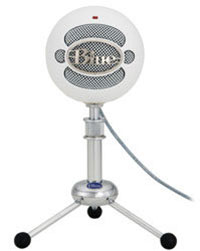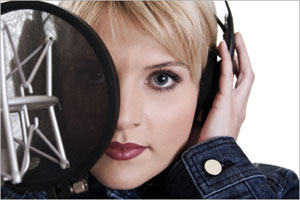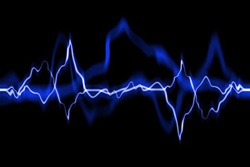
The Snowball, by Blue Microphones, is a large diaphragm USB condenser microphone that is, at the very least, unique in shape and appearance. I can say that I’ve never used a spherical microphone before, so I looked even more forward to testing it out than usual.
The first thing I noticed was that the actual mic was larger than I thought it would be, having only seen pictures of it. It is about as large as a softball, about 4 inches in diameter. It has a standard microphone stand coupling (hole) so you can use any stand you have. But it comes with a shiny chrome tripod desk stand as seen in the picture on the left, with rubber feet, which helps prevent noise from the desk traveling through the stand and into the mic. This makes it very handy for voice-over applications and as well as computer communication for use with as Skype, and other on-line conferencing applications.
The Specs
The Snowball is a 44.1KHz/16-bit mic. In digital audio sound must be converted to ones and zeros (digital). USB mics have converters built right into them, which is what makes them so handy. Standard mics must be plugged into a separate interface with converters inside. Motherboard sound cards also have converters, but they are of low quality and not recommended for recording. Anyway, moving on with the specs.
There is a switch on the back of the mic with 3 positions. The manual reveals these 3 positions to be:
- First Position – activates cardioid capsule
- Second Position – activates the cardioid capsule with a -10dB PAD
- Third Position – activates the omni capsule
So this microphone has two pickup patterns, cardioid and omni-directional. That’s pretty darned cool. Cardioid means it picks up sound best that is in front of the mic, rejecting what’s behind and to the sides of it. This helps keep noise down. Most mics default to that pickup pattern. Omni-directional is just what it sounds like. It picks up sound equally from all directions – behind, below, above, etc. – a 360-degree sphere. This setting is useful for small singing groups (can gather around the mic), conferences, interviews, and environmental recordings (using a laptop I guess). A word of warning about the omni setting though – if your recording space is not ideal, the omni pattern will pick up a lot more noise and room echo/reverb than the cardioid pattern.
Set up was a breeze. I was wondering how to adjust the angle and tried shifting it around. To my delight it reacted exactly as I had hoped, swiveling on a ball-and-socket joint built into the mic. Very nice.
I tried it on a Windows 7 (32-bit) machine, attaching and plugging in the included USB cable. Windows automatically installed the driver when I plugged int the cable, in about 15 seconds, and it showed up as an audio device called Blue Snowball in Devices and Printers.
Next I opened Reaper, my standard recording software program, to actually test out how it sounded. First I wanted to see if it showed up as an available mic, so I went to Preferences (Ctrl-P), changed the Audio system to “DirectSound” (it had been set to ASIO for my Focusrite Scarlett 2i2 Interface), and voila! Under Input Device was “Microphone (Blue Snowball).” Excellent and so very easy.
How Does It Sound?
The first thing I wanted to check for was the low-level hiss I have noticed in all the USB mic I’ve used to date. The result? Holy cow! I couldn’t believe how quiet the Snowball was, especially compared to the Samson C01U USB mic, which is a comparable product, even costing the same. The Snowball is $69.99 and I picked up the C01U at Best Buy for $70.
So the first thing I did was record a of seconds of silence with both mics. Then I recorded my voice into both mics, reading the same short passage.* The result was still pretty amazing. The hiss is quite loud in the Samson, where there is no hiss at all in the Snowball. In fact, you can actually hear the clock on my wall ticking in the Snowball sample. Take a listen to both samples below.
Audio Player
Samson C01U – silence only
Audio Player
Snowball – silence only
How did the voice recordings sound? Well this is where it gets interesting. Though they both sounded good, the Samson C01U sounded a bit better to me, more balanced and full. I also noticed that the Snowball picked up more of the room sound (a bit echo-y). However, the Snowball was much better at not over-emphasizing plosives (p-pops), which is a big plus in my book. Normally, even using a pop-filter in front of a mic, I still have to edit out the p-pops in my vocal recordings. Not only did I not need a pop-filter for the Snowball, but there was no need to edit them out as usual.**
Upon double-checking I discovered that the Samson’s pickup pattern is actually “hyper-cardioid,” (compared just “cardioid” for the Snowball), which means that it will pick up less room sound from the back and sides of the mic, but also make it more sensitive to plosives. This explains why the Snowball sample had more room sound in it, but fewer problems with the popping “Ps”. Listen to the 2 samples below.
Audio Player
Samson C01U – voice recording
Audio Player
Snowball – voice recording
They’re both very good, just different. And at least some of that difference is explained by the different pickup patterns. Looking at several reviews on the web comparing these same two mics, I found that some folks preferred the Snowball and others liked the Samson better. I think this is a case of personal preference.
Summary
Overall I give the Snowball high marks. It gets maximum style points – it just looks cool. It also generated less self-noise than any other USB mic I’ve used. And on the most important scale – sound quality – the Snowball is very good, especially for the price. To find out more, or purchase one of your own, click here: Blue Snowball USB Microphone.
* I “normalized” the levels of both mics to make sure the differences in noise volume were not affected by sensitivity and gain differences.
** I did not use a pop-filter with either mic in either test recording, nor did I edit them out. This allows you to hear how prevalent they are in the Samson but not in the Snowball.
 When a band records a song, the engineer needs to get the different instruments on different tracks in order to mix and edit everything properly. These days, when track-count is not an issue (due to computer recording – in the 1960s for example, The Beatles only had 4 tracks to work with most of the time!), it isn’t unusual to have 50 tracks or more, each with a different take for every musician in the band.
When a band records a song, the engineer needs to get the different instruments on different tracks in order to mix and edit everything properly. These days, when track-count is not an issue (due to computer recording – in the 1960s for example, The Beatles only had 4 tracks to work with most of the time!), it isn’t unusual to have 50 tracks or more, each with a different take for every musician in the band. You are probably familiar with WAV files. They are pretty much the default audio file for computers. They are uncompressed, non-lossy audio files, which means that they are typically large in size – mainly because WAVs are high-quality files. This is in contrast to MP3 and other audio file types you see on the internet, which have had audio information removed and compressed and otherwise mangled to make the file size small enough to work on the internet. Technically MP3s are not as as good as WAV files for audio quality.
You are probably familiar with WAV files. They are pretty much the default audio file for computers. They are uncompressed, non-lossy audio files, which means that they are typically large in size – mainly because WAVs are high-quality files. This is in contrast to MP3 and other audio file types you see on the internet, which have had audio information removed and compressed and otherwise mangled to make the file size small enough to work on the internet. Technically MP3s are not as as good as WAV files for audio quality.